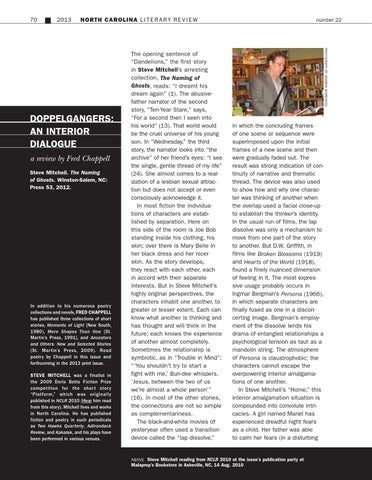70
2013
NORTH CAROLINA L I T E R A R Y RE V I E W
a review by Fred Chappell Steve Mitchell. The Naming of Ghosts. Winston-Salem, NC: Press 53, 2012.
In addition to his numerous poetry collections and novels, Fred Chappell has published three collections of short stories, Moments of Light (New South, 1980), More Shapes Than One (St. Martin’s Press, 1991), and Ancestors and Others: New and Selected Stories (St. Mar tin’s Press, 2009). Read poetry by Chappell in this issue and forthcoming in the 2013 print issue. Steve Mitchell was a finalist in the 2009 Doris Betts Fiction Prize competition for the shor t stor y “Platform,” which was originally published in NCLR 2010 (Hear him read from this story). Mitchell lives and works in North Carolina. He has published fiction and poetry in such periodicals as Two Hawks Quarterly, Adirondack Review, and Kakalak, and his plays have been performed in various venues.
photograph by Andrew Morehead
Doppelgangers: An Interior Dialogue
The opening sentence of “Dandelions,” the first story in Steve Mitchell’s arresting collection, The Naming of Ghosts, reads: “I dreamt his dream again” (1). The abusivefather narrator of the second story, “Ten-Year Stare,” says, “For a second then I seen into his world” (13). That world would be the cruel universe of his young son. In “Wednesday,” the third story, the narrator looks into “the archive” of her friend’s eyes: “I see the single, gentle thread of my life” (24). She almost comes to a realization of a lesbian sexual attraction but does not accept or even consciously acknowledge it. In most fiction the individuations of characters are established by separation. Here on this side of the room is Joe Bob standing inside his clothing, his skin; over there is Mary Belle in her black dress and her nicer skin. As the story develops, they react with each other, each in accord with their separate interests. But in Steve Mitchell’s highly original perspectives, the characters inhabit one another, to greater or lesser extent. Each can know what another is thinking and has thought and will think in the future; each knows the experience of another almost completely. Sometimes the relationship is symbiotic, as in “Trouble in Mind”: “‘You shouldn’t try to start a fight with me,’ Bun-dee whispers. ‘Jesus, between the two of us we’re almost a whole person’” (16). In most of the other stories, the connections are not so simple as complementariness. The black-and-white movies of yesteryear often used a transition device called the “lap dissolve,”
number 22
in which the concluding frames of one scene or sequence were superimposed upon the initial frames of a new scene and then were gradually faded out. The result was strong indication of continuity of narrative and thematic thread. The device was also used to show how and why one character was thinking of another when the overlap used a facial close-up to establish the thinker’s identity. In the usual run of films, the lap dissolve was only a mechanism to move from one part of the story to another. But D.W. Griffith, in films like Broken Blossoms (1919) and Hearts of the World (1918), found a finely nuanced dimension of feeling in it. The most expressive usage probably occurs in Ingmar Bergman’s Persona (1966), in which separate characters are finally fused as one in a disconcerting image. Bergman’s employment of the dissolve lends his drama of entangled relationships a psychological tension as taut as a mandolin string. The atmosphere of Persona is claustrophobic; the characters cannot escape the overpowering interior amalgamations of one another. In Steve Mitchell’s “Home,” this interior amalgamation situation is compounded into convolute intricacies. A girl named Mariel has experienced dreadful night fears as a child. Her father was able to calm her fears (in a disturbing
above Steve Mitchell reading from NCLR 2010 at the issue’s publication party at
Malaprop’s Bookstore in Asheville, NC, 14 Aug. 2010
